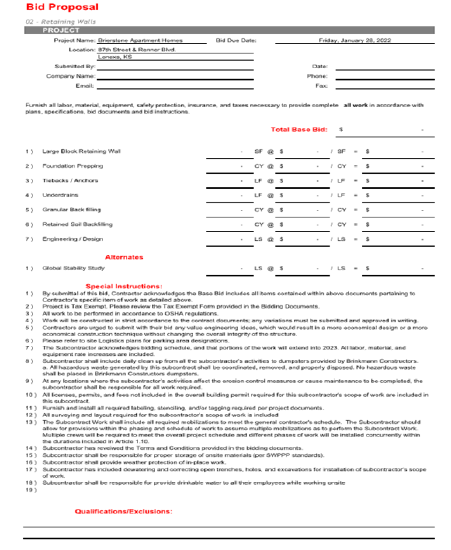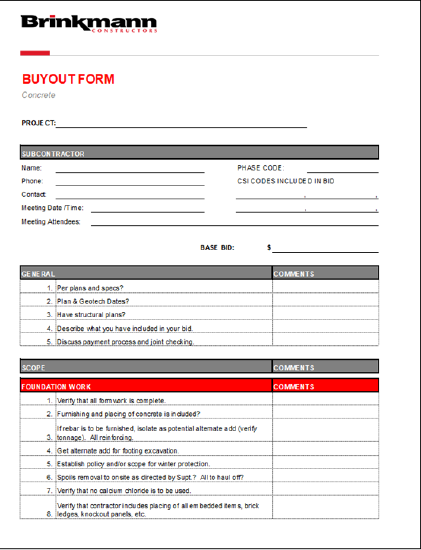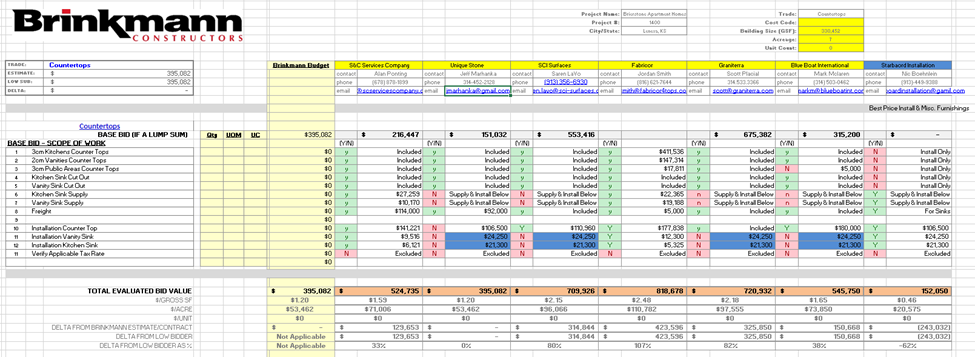|
Execution
- Buyout Meetings
- Review the Scope
- Prepare Buyout Notes
- Set up meetings with multiple subcontractors
- Meet with the highest subcontractor first
- Obtain pricing for complete scope
- Don't shop bids and no last looks. It is unethical.
- Award to low qualified subcontractor
- Call, not email, the #2 sub first
- Use meetings as a learning tool
Buyout Meetings
- After selecting / shortlisting bidders through the Sub Bid Analysis process, set up buyout meetings with bidders.
- Note: some scopes may require detailed buyout meetings with multiple subcontractors to ensure bids are accurately reviewed. Others may be a quick phone call. (Know the project risks)
- Make sure the estimator and operations side for the bidding party are in attendance at this meeting.
- Bidder should bring any sequencing plans, detailed schedules, take-offs, assumptions, questions, RFI's, etc.
- Ensure the bidding party has received and reviewed the standard Terms and Conditions prior to the meeting. Go over the Terms and Conditions during the meeting again.
- Get the bidders talking. Don't be the one doing all the talking!
- Take detailed meeting minutes, including action items, and issue within 24-hours.
Buyout Meetings: EMR & Subcontractor Bond Rate
- To encourage a stronger emphasis on safety and risk management to all aspects of our operations, the buyout process includes discussion of the Experience Modification Rate and Subcontractor Bond Rate with all subcontractors that are to potentially be awarded work.
- The hope is that focusing on these specific metrics will shed light on risk associated with subcontractors from both a financial and safety perspective.
- What is it? For those not familiar with this criteria:
- Bond Rate: A Bond Rate will often range from 1% - 5%, with anything over 2.5% being considered an indicator of financial risk.
- The EMR (Experience Modification Rate): The average EMR rate is 1.00, with anything over 1.00 noting a higher-than-average safety risk (based on past experience).
- Procedure
- The EMR and Subcontractor Rate information is part of the standard Buyout Form to be used when awarding subcontracts. This information is to be discussed at the Buyout Meeting.
- Additionally, the subcontractors should address the contract language concerns during this meeting.
- (NOTE: This is not a replacement of other risk mitigation efforts currently in place, but an intentional effort to bring these items to the front of our first in-person interaction with a subcontractor)
Below is an optional cut/paste communication that may be used to set up the meeting.
SAMPLE COMMUNICATION
Dear XXX,
Thank you for providing a bid proposal for the XXXXXX scope of work for the XXXXX project. Brinkmann is considering utilizing your company for this project and would like to discuss your proposal in person in further detail.
Please join us at <insert office / location for meeting> at X:XX on XXXXX (day of the week), XXXXX (Date). Please bring the estimator who bid this project and be prepared to discuss your estimate in detail.
Additionally, please bring the Project Manager and Field Operations Manager you propose for the project if possible and be prepared to discuss your Experience Modification Rate (EMR) and your Bonding Rate.
Finally, please be prepared to discuss any modifications that would be required to partner under the Sample Subcontract PDF that was included in the “Contract Documents & Requirements” folder in Smartbidnet.
We look forward to discussing this project in more detail with you
|
Finalizing Bidder Pricing and Awarding Scopes of Work
- Once all updated bidder pricing has been received, reviewed, and agreed upon, subcontractors and purchase orders should be issued.
The Scope - Buy Our Subcontract and the Language
- Provide blank subcontract for them to review and clarify that it is non-negotiable if they would like the project. This should be done at the buyout meeting.
- Note: A sample Subcontract, Purchase Order, Insurance Certificate, and Sub Memo was included as part of the standard bidding documents on SmartBid when sent out to bid
- Confirm insurance requirements
- Payment Terms - Discuss Joint Check and GC Pay
- Buy hourly rates but know the market and negotiate
- If discussed, it goes into the subcontract
- Do NOT sneak in verbiage if you didn't discuss it
- Sub Qual Forms and Bonding Capacity
Schedule
- Clarify the schedule that we need. Don't ask how how long it will take to complete.
- Confirm submittals and procurement timeframes meet our schedule
- May need to buy multiple crews
- Buy durations, not dates
- Be careful buying number of workers
Quality and Safety
- Any specific requirements that need to be met for their scope of work?
- Mock-Up, Always!
- How are you buying clean-up?
- Make sure all OSHA regulations and requirements are acknowledged and met
- 6' Fall Protection is Brinkmann standard - not an industry standard
- Silica Standard
|
|
Bid Proposal Forms
- The purpose of a Bid Proposal form is to help organize bidders' costs to accurately review and ensure full scope coverage.
- A bid proposal form may not be required for all scopes of work due to size and/or complexity of the scope of work. This should be determined by the project manager for accurate bid reviews.
- Bid Proposal Forms should be sent out with, or quickly after, the initial invitation is sent on SmartBid.
- Be sure to update and add special notes, bidding instructions, requirements, etc. on the forms to help guide the bidders.
- Below is an example of a Retaining Wall bid form.

Buyout Forms
- Must complete in detail for every scope
- Buyout is the opportunity to eliminate scope gap and avoid profit fade
- Comes from check set/scope take-off
- Used as a template to draft the subcontract
- EMR & Bond Rate: Part of a recent initiative is to bring stronger emphasis on safety and risk management to all aspects of our operation. As part of this, we have added fields to our buyout forms to include Experience Modification Rate and Subcontractor Bond Rate. Please see the information stated above in "The Buyout Process" for further details on how this process is to be managed.

|
Sub Bid Analysis
- This is not a buyout form, but rather a tool to organize and look over multiple bids to ensure accurate bid comparison.
- Many GMP and Cost of Work prime contracts will require a sub bid analysis completed and recommendations sent to the owner for approval. Know your Prime Contract so we can be prepared.
- Each scope of work, purchase orders and subcontract, should be reviewed utilizing the Sub Bid Analysis Form.
- If done properly, you can clearly see scope gaps by different bidders, and it will help you accurately update project estimates.
- Best Practices/Tip:
- If you create a detailed Bid Proposal Form, it will help you organize your bidders costs accurately.
- Understanding how bidder's breakdown bids is important, and what the project/owner will require. This will help you fill out the bid section of the overall estimate.
- Do you need to breakout the building into phases/sections?
- Do you need to separate finishes from shell and core?
- Does the owner need to know specific costs about certain items?
- Below is an example of a Countertop Bid Analysis:

- Base Bid Scope of Work: Itemized Detail/Breakdown for specific scope items.
- Brinkmann Budgets: Current Brinkmann budget for the specific scope of work. (Think the phase code budget).
- Bidders (Yellow Bars): Input all bidder information
- Best Practice - As soon as we receive the bid, we should add them to the sub bid analysis sheet, and then the bid book.
- Review the bid and update the specific line-item cost and determine the following:
- Specific price for scope item (best option)
- Y: Included in overall price or elsewhere within the breakdown
- N: Not included in the overall price or elsewhere within the breakdown
- To normalize the bid, we need to get another bidders price to fill in the gap, or provide an estimated cost to complete the specific line item.
- C: Contingency. May be applied if we have a risky subcontractor, some vague drawings, or other project risks.
- The goal is to accurately review the estimated costs for each bidder performing the work and select the best subcontractor to perform the work.
|
|
Buyout Strategy
- Buy Hard. Firm but fair
- Get all included up front - No change orders later. Touch it once - Field and Office.
- All leverage is lost once awarded
- Spend the most time on high risk and large scopes
- Critical items first
- Unit costs and bid breakdown helps understand scope gap and overlap
- Gut feeling when you sit down
- Sit down with as many as you can
- Weigh risks and size of subcontract scope
- Art of "Buying the Grey" and Missing information
- How are they going to perform their work?
- What do you need them to include that is not specifically shown on the drawings?
- What CO's came up on past projects?
- Review all exclusions and don't gloss over them
- Understand who will be 1099 or piecemeal workers
- Get them talking
|
Risky Subcontractors: What to Look For and Require
- Prequalification Form
- Right size for the job
- Some projects may be too large for the sub. Look for past experience and compare.
- Manpower Availability
- Financial Stability
- How much can they bond for?
- How much backlog do they have?
- What is their current cashflow?
- Discuss payment terms
- 2nd Tier Subcontractors and Suppliers
- How much of the work are they subbing out? See if those subs can attend the buyout meetings
- Director involvement with risky contractors
- Review risk concerns and considerations with directors prior to award
- Get references and call them to see what the other GC's have to say
|





